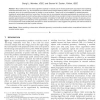5 search results - page 1 / 1 » Stereo for Slanted Surfaces: First Order Disparities and Nor... |
EMMCVPR
2005
Springer
15 years 11 days ago
2005
Springer
Traditional stereo algorithms either explicitly use the frontal parallel plane assumption by only considering position (zero-order) disparity when computing similarity measures of ...
CVPR
2007
IEEE
15 years 8 months ago
2007
IEEE
Two new techniques are proposed to improve stereo matching performance in this work. First, to address the disparity discontinuity problem in occluded regions, we present a dispar...
CVPR
2006
IEEE
15 years 8 months ago
2006
IEEE
Belief propagation has been shown to be a powerful inference mechanism for stereo correspondence. However the classical formulation of belief propagation implicitly imposes the fr...
3DPVT
2004
IEEE
14 years 10 months ago
2004
IEEE
We examine the implications of shape on the process of finding dense correspondence and half-occlusions for a stereo pair of images. The desired property of the depth map is that ...
PAMI
2010
14 years 5 months ago
2010
—Many traditional two-view stereo algorithms explicitly or implicitly use the frontal parallel plane assumption when exploiting contextual information since, e.g., the smoothness...


